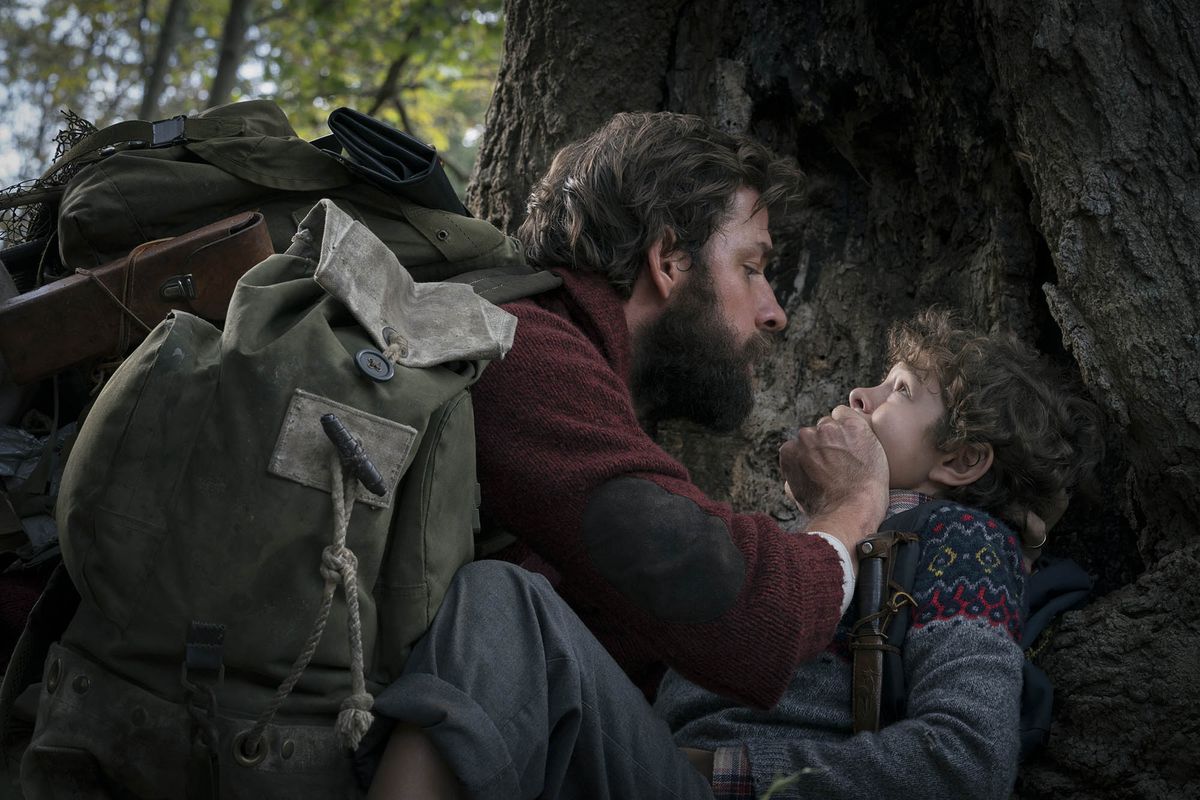A Quiet Place
Bruce Steele: After the disappointing mess that was It Comes at Night, what do we think of the latest post-apocalyptic story about a family barricaded in an isolated country house in a mysteriously deadly world, A Quiet Place?
Edwin Arnaudin: It moves well, has a few decent scary payoffs and, like its handful of characters, encourages viewers not to make a sound — a neat thing to experience in a full theater — but left me feeling mostly empty. How’d it play for you?
Bruce: I liked it. It kept me on the edge of my seat but didn’t resort to extreme violence. It’s basically a fairy story: Once upon a time, blind monsters with sharp ears, lots of teeth and superfast legs killed almost everyone on Earth, but the Abbott family has an advantage. Because the oldest daughter is deaf, they all know sign language and can live in almost complete silence. The screenwriters put some effort into the practical details of how this would work, but you can’t think too much about it. Did you have credibility issues?
Edwin: There are a few inconsistencies with the creatures’ abilities that somewhat lessen their threat level, but I otherwise bought into the scenario. I just wish the world was a little more developed. Maybe this adventure with the Abbotts is Part One in a larger story, but either way the premise’s inherent lack of complex communication limits the film’s emotional power for me.
Bruce: I actually admired the restraint in providing back story. The rules are clear from the first traumatic and gripping sequence, which resonates through the rest of the movie. I think we’re to assume the creatures are aliens, but I like the 10 Cloverfield Lane approach: The danger just IS. It’s part of the movie’s overall economy in storytelling, which for me added to the emotional power.
Edwin: I’ll also admit that for much of A Quiet Place, I was angry at the family for — well, to not spoil things, let’s say they put themselves in a situation that will eventually lead to a vast increase in their noise output. When a solution to the problem is presented that appears to work, my issues largely subsided, but the frustration up to that point is tied in with not caring much about the Abbotts as people, despite rooting for their survival. Did you feel attached to them beyond a desire of them maintaining a pulse?
Bruce: Yes, I genuinely liked them, despite their plot-imposed failings, probably largely due to the cast: Emily Blunt is almost always a charmer, and her silent acting here is painfully great. And director, co-writer and star John Krasinski does well-meaning but flawed Dad really well. The two older children are both, forgive the joke, wonders: Millicent Simmons from Wonderstruck, a deaf actress in a deaf role, and Noah Jupe from Wonder, as a perpetually terrified boy. I think both kids have bright futures.
Edwin: Other than Blunt, whose terror manifests itself in numerous dramatic ways, everyone has one scared facial expression to which they return often. Perhaps they’re capable of more, but under Krasinski’s direction they show minimal range. The monsters, however, are endlessly fascinating to watch. Were you similarly awed by their design?
Bruce: They looked really good, like the Alien alien redesigned by Tim Burton. I couldn’t make any biological sense out of them, but I wrote that off to the fairy tale premise. I wish they’d displayed a dollop of intelligence or social behavior, though. Personality can always enhance menace.
Edwin: I saw some Little Shop of Horrors inspiration in them, too. But yes, a little velociraptor camaraderie or sense for problem-solving would have gone a long way. Still, the silence they inspire from their potential prey and our audience following their lead was impressive and something to which I feel I should give more credit. Have you had a theater-going experience like that before?
Bruce: That was fabulous, I agree. The kid next to me in our sold-out late Thursday show had brought food from home and had a devil of a time unwrapping it in the silent theater. It’s worth going to a crowded show just for that experience. But it seems movies about remaining silent win me over more easily than you, since I liked A Quiet Place more than you did, just as it was with 2016’s Don’t Breathe. Maybe the silence gives you too much time to overthink, Edwin.
Edwin: I think I’m just disappointed that both Krasinski and Don't Breathe's Fede Alvarez craft a breathless atmosphere, then largely fail to capitalize on its potential. There should be far more moments in Krasinski’s film where the suspense is borderline overwhelming, and also a greater number of jump scares. Then there are other components like a certain, let’s say, impediment on the basement stairs that’s clunkily introduced and plays out exactly how one expects. For such a creative premise, there aren’t that many surprises.
Bruce: The eventual twist isn’t that surprising, but it made me happy and works effectively. More scares would have been fine, but I was also fine with the movie’s more mild demeanor, more family drama than scary movie. It’s lean and neat and enjoyable, and I loved the cast — although I think I’d prefer a prequel to a sequel. I give it a B-plus.
Edwin: It also sports a terrific final shot, even if it's not completely earned. For all my qualms, I still had a good time overall and would recommend it. But like the similarly overpraised It Comes at Night, It Follows, The Babadook and A Girl Walks Home Alone at Night, I don't consider it The Next Great Horror Film. B-minus for me, and that feels a little generous.
Grade: B. Rated PG-13. Now playing at AMC Classic, Biltmore Grande and Carolina Cinemark
(Photos: Paramount Pictures)






